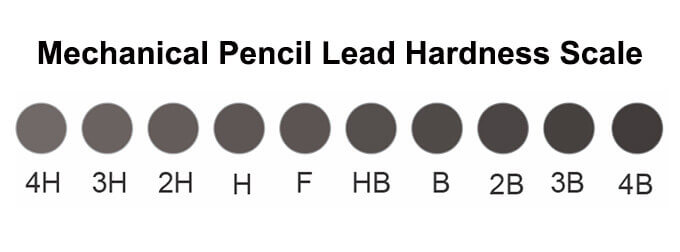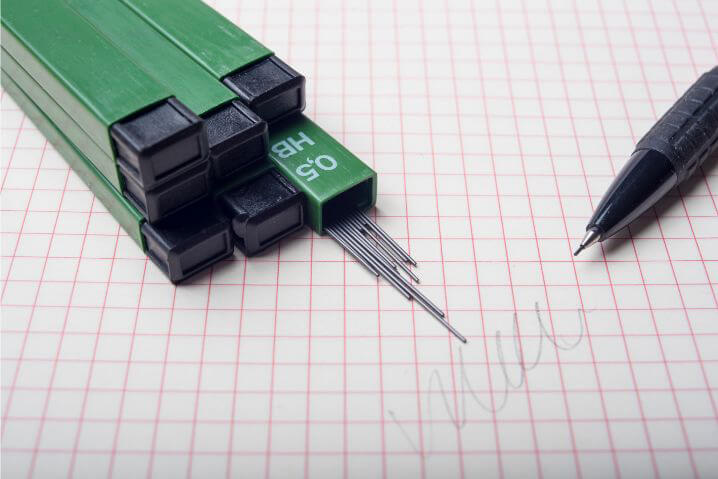Are you confused about which lead grade to use in your mechanical pencil?
When it comes to choosing a mechanical pencil lead grade, there are several factors to consider which will help you get the optimal lead for your writing or drawing.
This guide will help you navigate the labyrinth of lead grades to make an informed choice the next time you buy lead for your mechanical pencil.
Table of Contents
1. Understanding Mechanical Pencil Lead
Firstly, let’s demystify what mechanical pencil lead is. Contrary to its name, it’s not composed of lead but a mix of graphite and clay.
We covered this in detail in our guide. What is Pencil Lead Made Out of?
The graphite-to-clay ratio determines the hardness or softness of the lead and, subsequently, the darkness or lightness of the mark it makes on paper.
Mechanical pencil leads are designed specifically for mechanical pencils, offering the convenience of continuous writing or drawing without the need for frequent sharpening.
Although mechanical pencil lead is made from slightly different materials than that used to make traditional wooden pencils, check out The Complete Guide to Mechanical Pencils Lead Grades for more information.
They are available in various thicknesses and hardness grades to suit different purposes. Now, let’s delve deeper into the mechanics behind mechanical pencil lead.
2. Mechanical Pencil Lead Grades
Mechanical pencil leads come in various thicknesses and hardness grades, allowing users to choose the most suitable option.
The hardness of the lead is represented by the HB scale, a widely accepted international standard used to measure the hardness and darkness of pencil leads.

The Wooden pencil HB scale ranges from 9H to 9B, with H indicating hardness and B indicating blackness.
However, mechanical pencil lead is only available from 4H to 4B
The number in front of the H or B indicates the degree of hardness or darkness, with higher numbers representing higher levels of each attribute. The scale’s HB midpoint represents a perfect balance between hardness and blackness.
On the harder side of the scale, you’ll find leads labeled with an “H” followed by a number (e.g., H, 2H, 3H, etc.). These leads have a higher proportion of clay in their composition, making them harder and lighter in color.
As the grade number increases, the lead becomes harder, and the mark on the paper becomes lighter.
Hard leads are favored for precise work that requires clean, sharp lines, such as technical drawing, drafting, or light sketching.
They resist smudging and maintain a sharp point for longer, making them ideal for tasks that demand precision and neatness.
On the softer scale, you’ll find leads denoted by a “B” followed by a number (e.g., B, 2B, 3B, etc.). These leads have a higher graphite content, making them softer, darker, and more prone to smudging.
As the grade number increases, the lead becomes softer, and the mark it leaves on the paper becomes darker and bolder. Soft leads are popular among artists for sketching, shading, and any work requiring a wide range of tonal values. They provide richer blacks and can create a variety of textures based on the pressure applied.
The HB and F leads lie in the middle of the HB scale, which balances hardness and darkness.
HB leads, being the scale’s midpoint, offer a blend of the precision of hard leads and the dark lines of soft leads.
They are versatile and well-suited for general writing and sketching. F (Fine point) leads, slightly harder than HB, are excellent for precise work that requires a slightly darker line than hard leads but with less smudging.
They are a popular choice for technical writing and drawing among engineers and professionals.
Choosing the Right Lead Grade
3. Choosing the Right Lead Grade
Choosing the right mechanical pencil lead grade is not a one-size-fits-all decision. Several factors come into play, each influencing your choice based on your needs, style, and preferences.
3.1. Writing Style
The style of writing heavily impacts the choice of pencil lead grade. For calligraphy or other forms of expressive writing, softer leads (B grades) that provide bold and dark lines can be ideal, as they enhance the beauty of each stroke. On the other hand, for note-taking or general handwriting, a medium-grade lead like HB or F is often preferred, as it balances darkness and durability.
3.2. Artistic Needs
For artists, the choice of lead grade becomes even more crucial as it directly affects the output of their sketches or drawings. Technical drawings that require precise, sharp lines are best done with harder leads (H grades). On the other hand, softer leads (B grades) are excellent for sketching and shading, providing a broader range of tonal values. Artists seeking a versatile option may opt for middle-of-the-road leads like HB or F, which balance precision and darkness.
3.3. Hand Pressure
The amount of pressure you exert when writing or drawing is another vital factor. Harder leads are a good choice if you’re heavy-handed, as they’re less likely to break and can withstand more pressure. On the contrary, if you’re right-handed, softer leads can help you achieve darker lines without applying too much force.
3.4. Paper Type
The type of paper you’re using also plays a role in selecting the lead grade. Rougher papers are better paired with harder leads that can withstand the texture, while smoother papers can handle softer leads well. A harder lead is also advisable to prevent potential bleed-through if the paper is thin.
4. Personal Preference
Lastly, personal preference often has the final say in choosing a pencil lead grade. Some people naturally gravitate towards the feel of specific lead grades.
Whether it’s the smooth glide of a soft lead or the firm resistance of a hard lead, choosing what feels most comfortable and enjoyable for you is essential.
After all, the best tools are the ones that make you want to create more.
Check out our Ultimate Guide to the Best Mechanical Pencil Lead for our top recommendations
5. Tips for Choosing the Right Lead Grade
Testing different mechanical pencil lead grades is the key to finding the one that perfectly matches your needs and style. Here are some recommendations on how to effectively try out various lead grades:
- Obtain a range of leads: Purchase individual leads or a set that includes a variety of hardness grades.
- Test on your preferred paper: Try each lead on the same type of paper you usually use, as this will give you the most accurate understanding of how each grade performs in your regular use case.
- Compare the results: For each grade, write or draw the same line, phrase, or sketch, noting the differences in darkness, smudging, and feel. Remember the pressure you typically use, as this can also impact the appearance and feel of each lead grade.
- Experiment and explore: Finding the right lead grade is often trial and error. Experimenting and understanding that what works for one person might not work for you is important. By trying out different lead grades, you allow yourself to discover the grade that feels most natural and comfortable for you.
6. Conclusion
Selecting the correct mechanical pencil lead grade significantly enhances your writing or drawing output.
Whether you’re an artist seeking bold, expressive lines or an engineer looking for precision, the right lead grade will meet your needs.
Remember, there’s no one-size-fits-all solution. Experiment with different grades to discover what suits you best.
Keep sketching, keep writing, and enjoy the process!

Wow. A fellow writing utensil geek! Thank you for existing and a big thanks for answering my long-time question of how lead is graded. Peace.